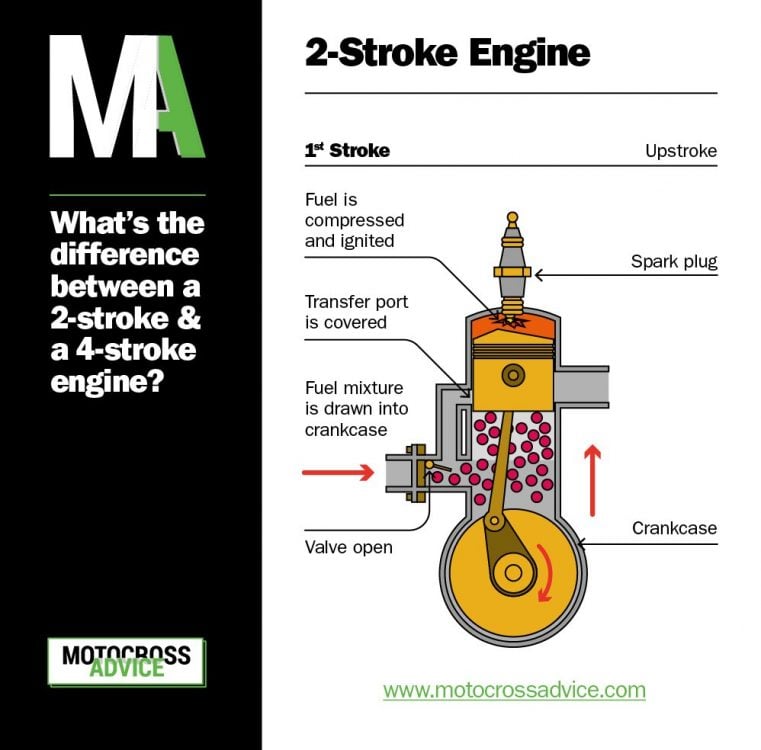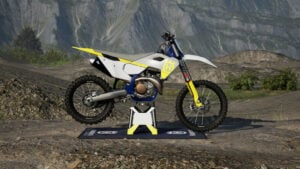We are reader-supported. When you buy through links on our site, we may earn an affiliate commission. Learn More…
2 Stroke vs 4 Stroke Engine [With Graphics] – The Ultimate Beginners Guide
There is a question that has been bandied around since the dawn of motocross time. Riders have debated this contentious subject in forums, at the trackside and in dealerships all over the world. Which makes the best dirt bike? Is it 2 stroke, or is it 4 stroke? Motocross Advice can finally bring you the definitive answer – The Ultimate Guide: 2 Stroke vs 4 Stroke Dirt Bike Engine.
Drum roll, please!
The answer is that it depends on what kind of riding you are doing and what level of ability you have.
So don’t listen to the 2 stroke warrior who is berating 4 stroke riders at your local meet, telling you that you are not a “real dirt bike rider” unless you ride a stroker. Neither should you listen to the know-alls who promise you the low maintenance costs and smooth-riding of a 4 stroke. There is always going to be someone who will be ferociously defending their opinion, and telling you what you should think.
Sorry, that probably isn’t what you wanted to hear, but it is the truth of the matter, and we always want to tell you the truth.
And here is the truth;
Why ask the question 2 stroke vs 4 stroke?
There are many factors to consider. You have to make the right decision for you. To do that you must understand the differences between the two types of engine. That is why we are here today.
This article will compare two bikes, like for like. So that we make it a fair comparison, we are going to look at bikes which share precisely the same chassis and running gear. When it comes to a second-hand dirt bike, there are far more variables. How you ride a dirt bike, and how regularly it has been serviced all come into play.
The two brand new bikes we will compare are:
The 2020 KTM 250 SX-F 4 stroke and the 2020 KTM 250 SX 2 stroke.
We are not reviewing or recommending either bike as a first purchase, although both are incredible machines. We are only looking for characteristics common to each style of engine.
To build a picture of characteristics, we will look at the following factors:
Bike Stats:
Max Power output
Service intervals
Service costs
Engine Rebuild costs
Price
Weight
Finally, we will see how each bike performs with key rider stats in mind: Weight, physical ability, riding style and skill level. Before we get into the shoot-out, let’s answer the most regularly asked question:
What’s the difference between a 2 stroke and a 4 stroke internal combustion engine?
To make sense of the names, you will need to understand the primary functions of an engine. Creating power at the back wheel requires engines go through a cycle of events:
- Firstly an engine draws a mixture of fuel and air into the chamber via a piston. This process is called “intake”.
- A spark ignites this mixture. This process is called “Combustion”.
- The resulting energy turns into a “power stroke” which drives a series of gears and drivetrains to deliver power to the back wheel.
- Finally, the engine dispenses waste gases, via the dirt bike exhaust system.
As you can see, there are four processes here. Hold that thought.
The up movement of the piston is one stroke. The downward motion is another stroke. A four-stroke completes all of the engine process listed above in two revolutions of the cam. You guessed it, that is four strokes.
A two-stroke completes all four engine processes in just one revolution of the cam or two strokes.
With us so far?
It is not straight forward, don’t worry if you are getting bogged down. To make things a little clearer, we have had our design team put together a couple of easy to understand graphics.
What happens in a two-stroke engine?

* 2 stroke engine first stroke – Upstroke

* 2 stroke engine second stroke – Downstroke
You have to make the right decision for you. To do that you must understand the differences between the two types of engine.
What happens in a four-stroke engine?

* 4 stroke engine first stroke – Downstroke – intake

* 4 stroke engine second stroke – Upstroke – Compression

* 4 stroke engine third stroke – Downstroke – Power

* 4 stroke engine fourth stroke – Upstroke – Exhaust
Right. We understand how the two engines work. (sort of)
How do our sample 2020 KTM 250 SX-F and SX stack up on paper?
There are several key differences between our two sample bikes. For example, off the shelf, they have different engine management systems, and different clutch setups and so on.
We are not going to get sidetracked with the exact differences of each bike. We will deal only with the measurable variables. After all, we are interested in how they perform head to head, right?
Suffice to say the bikes have the same chassis, running gear and manufacturer.
Weight comparison dry: 209lb (95KG) 2 stroke and 218.3lb (99KG) 4 stroke
Why is this important to me?
The four-stroke is a heavier bike, but only by a margin of around 10KG. If you are looking at older second-hand bikes, the heavier weight of the four strokes may be more significant. Older technologies and designs weighed more. So if you are buying on weight alone, a two-stroke has the edge.
Averages from three separate dyno session on each bike produce the following approximate numbers. These are estimates based on multiple data collations.
Max Power output: 49 HP@8200 RPM (2 stroke) and 39 HP@13,200 RPM (4 stroke)
Why is this important to me?
The maximum power output is a very significant figure. To our way of thinking, where and how the power is delivered is your crucial influencer.
As you can see the maximum power of 49 HP on the 2 stroke is delivered in the mid-range at 8200 RPM. A mid-range surge like this is a massive dollop of power which kicks in hard and propels the bike forward with arm wrenching force.
The power curve shows that the 2 stroke then tails off fast from 8200 RPM up. In real-life terms, this means that the 2 stroke bike will be demanding far more gear changes so that it continually remains in the powerband. For you, this equates to a high level of rider engagement. Constant gas on, brake hard, gas on is normal for a 2 stroke. The power band is exceptionally narrow, and so you have to work hard to keep the engine boiling.
The four-stroke is an entirely different beast. It has a far broader and smoother power band, which runs through the mid-range, and up to the dizzy heights of 14,000 RPM. The peak 39 HP is lower than the 2 stroke, but that is only relevant if you can ride in the power band on the stroker. Ego’s aside; it takes an exceptional level of fitness and ability to continually be on the boil with the 2 stroke. Buying with your ego could be a big mistake.
The 4 stroke is a much kinder machine. If you are spending long days on the trails, you will thank the four-stroke for its more refined delivery of power. If you exit a corner in the wrong gear, it will pull from lower revs without making you look stupid. With a four-stroke, the torque is available on-demand, in multiple gears. Try the same sloppy riding on a 2 stroke, and it will bite you back by bogging down if you are in too high a gear, or ripping your arms out if you are too low.
Riding style suited to 250 2 strokes:
Hooligans, out and out competition racers with high levels of skill, and those who are fit enough to deal with the physical demands of riding the bike the way it wants to ride.
Should I forget the idea of 2 strokes if I am a beginner?
Not really. You could consider a 125 stroker instead. The power band is more manageable for new riders, and you still get to smell the 2 stroke and ride a bike that sounds like a startled wasp. Do bear in mind that a 125cc two-stroke works best if you are under 11 stone (160lbs). Any bigger and you should probably consider a different bike. If weight issues are not a problem for you, then the 125cc stroker will deliver similar performance to the 250 four-stroke.
Riding style suited to a 250 4 stroke
Any four-stroke crosser is going to forgive errors and yet will still perform on pace if you have the skills. We are not all world champions, but the four stroker is likely to make you feel like one more often than the 2 stroker will.
Put simply; the four-stroke will tick more boxes for a broader range of riders.
Price new $10,100 approx (2 stroke) and $10,500 approx (4 stroke)
Why is this important to me?
Price is probably the least significant number. However, a brand new 250 2 stroke is going to be slightly less than a brand new 4 stroke of the same size.
The price becomes a little more relevant if you can drop to the 125cc, stroker as you will save around $900.00 approximately. (That’s a new helmet and motocross boots by the way).
Price 2nd hand (‘17 model)
$4200.00 Dealer ( 2 stroke with80hrs) and $4729.00 Dealer ( 4 stroke with 70hrs)
The difference in price remains about the same with the second hand bikes too. However, do factor in the number of hours ridden. A four-stroke bike that needs a full valve service as soon as you buy it or god forbid, a complete engine rebuild, will hurt you in the pocket. If buying second hand, buy carefully!
A second-hand stroker, either 125 or 250 may well need work too. If you are handy with the spanners though, a two-stroke is far easier to work on as it has fewer parts and a more straightforward design. If you are having work done at a dealer a simpler design always translates into lower labour costs
Look at the service intervals below for a guide on when a service is required. An asterisk indicates when the valves will need checking. (Four-stroke only as the two-stroke has no valves). NB: Valve services can be costly.
Service intervals and minutes required for the service (KTM official Dealer)
2 stroke engine service intervals:
Service recommended @ 1hr will take approximately 39 minutes, plus parts.
Service recommended @ 5hr will take approximately 20 minutes, plus parts.
Service recommended @ 10hr will take approximately 69 minutes, plus parts.
Service recommended @ 20hr will take approximately 114 minutes, plus parts.
Service recommended @ 40hr will take approximately 214 minutes, plus parts.
4 Stroke engine service intervals:
Service recommended @ 1hr will take approximately 90 minutes, plus parts. Valves checked
Service recommended @ 10hr will take approximately 180 minutes, plus parts.
Service recommended @ 20hr will take approximately 220 minutes, plus parts. Valves checked
Service recommended @ 30hr will take approximately 250 minutes, plus parts.
Price for engine rebuild
$284.50 plus labour for the 2 stroke
$900.00 plus labour for the 4 stroke
2 stroke vs 4 stroke conclusion
OK, we know you really want an opinion, and so here they are. (Yes, there are more than one of them). Please remember, they are just opinions and mean nothing if you have your heart set on a specific bike.
Motocross Advice believes that a four-stroke is the best all-round choice for a beginner. If you are too large for a 125cc, or if you do not have the necessary skills/fitness to exploit the hooligan power of the 2 stroke, the 4 stroke will bring you far more enjoyment.
If you are a junior rider coming up from a mini bike and are aiming at fully competitive riding, then look at the 125cc stroker. You can learn some serious skills and have a lot of fun doing so.
If you are a very skilled rider, maybe ex-pro, or rapidly rising through the junior ranks, and you are looking for a competitive bike, the 2 stroke will be hard to beat in your hands. For more information about 2 strokes, read our ultimate guide to the best 2 stroke dirt bikes in 2020.
If you are an older rider, especially weighing over 160lbs, then forget the 125cc. You have a clear choice. Ride the hooligan bike and deal with the consequences if you have not got the physical ability to maximize its character, or ride a 4 stroke and just have a ton of fun.
2 stroke vs 4 stroke maintenance:
Any 2 stroke is going to be easier to maintain if you are handy with the spanners but could require more regular fixing up if you spank it like you are supposed to.
Yes, a 4 stroke is a little more expensive to run, but even a 4 stroke can be fixed up at home if you like mechanical work. Plenty of track day riders do their valve clearances on multi-cylinder sports bikes. Don’t listen to the prevailing narrative that it is too hard to self-maintain a four-stroke.
A four-stroke will deal with amateur trail riding all day long.
Ultimately you need to buy with your wallet, not your ego and be realistic about how physically fit you are. Also, be realistic about your skill levels.
2 stroke vs 4 stroke – which one will you pick?
Next up read our fresh review and buying guide about the best 2 stoke and 4 stroke dirt bike oil 2020.
We will be back soon with more Motocross Advice
Until then, be safe, and have fun!
Martin






Be the first to comment